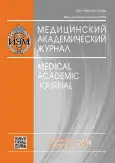THE EFFECT OF АFOBAZOL ON THE NEUROAMINE STATUS OF THE THYMUS OF WHITE RATS
- Authors: Gimaldinova NE1, Lyubovtseva LA1, Guryanova EA1, Vorobeva OV1
-
Affiliations:
- Chuvash State University named after I.N. Ulyanov, Cheboksary
- Issue: Vol 19, No 1S (2019)
- Pages: 201-202
- Section: Articles
- Published: 15.12.2019
- URL: https://journals.eco-vector.com/MAJ/article/view/19397
- ID: 19397
Cite item
Abstract
Often used in medical practice drug Afobazol has a wide range of actions. The paper describes the morphological changes of neuroamine-containing structures of the thymus of white rats with long-term (8 weeks) afobazole administration. By fluorescent histochemistry was determined by the content of catecholamines, histamine, and serotonin in the structures of the thymus. Under the influence of afobazole, the luminescent picture in the structures of the thymus changes, the clear boundary between the cortical and medullary substance of the thymus lobe is erased. The introduction of Afobazole leads to a decrease in the concentration of biogenic amines in premedullary GLA and an increase in the concentration in the microenvironment, which indicates a decrease in the amino-producing properties of these cells and the release of neurotransmitters from GLA.
Full Text
About the authors
N E Gimaldinova
Chuvash State University named after I.N. Ulyanov, Cheboksary
L A Lyubovtseva
Chuvash State University named after I.N. Ulyanov, Cheboksary
E A Guryanova
Chuvash State University named after I.N. Ulyanov, Cheboksary
O V Vorobeva
Chuvash State University named after I.N. Ulyanov, Cheboksary
References
- Yarkova MA. Anxiolytic properties of afobazol in comparison with diazepam. European Neuropsychopharmacology. 2005:S145.
- Bugaeva LI, Denisova TD, Sergeeva SA, Kharlamov IV. The Study of prenatal development of fetuses of rats treated with afobazole during the period of organogenesis. Bulletin of experimental biology and medicine. 2014;7:S64-67.
- Vorobeva OV. Dynamics of morpho-functional conditions of cellular programmed differentiation in bone marrow as a hemopoietic organ. Zhurnal anatomii i gistopatologii. 2017;6(2):26-29.
- Vorobeva OV, Lyubovtseva LA, Gimaldinova NE. Enzymatic provision of bone marrow cells after transplantation. Journal of anatomy and histopathology. 2018;7(3):9-12.
- Gimaldinova NE, Lyubovtseva LA, Plyukhin SV. Influence of cycloferon on the distribution of histamine in biomesotherapy structures of the thymus gland. In: Issues of medical rehabilitation. Collection of scientific works on the results of Interregional scientific-practical conference. Cheboksary; 2018. P. 113-116.
- Gimaldinova NE, Ignatieva EN, Lyubovtseva LA, et al. The effects of cycloferon on the distribution of neuroamines in bioamine-containing structures of the spleen. Bulletin of new medical technologies. 2018;25(3):101-106.
- Solenovata EA, Guryanova EA, Alekseeva LA. Analysis of the activity structures of the thymus and the ¬early immune response in patients receiving immunomodulator. Bulletin of Chuvash University. 2013;(3):511-516.
Supplementary files







